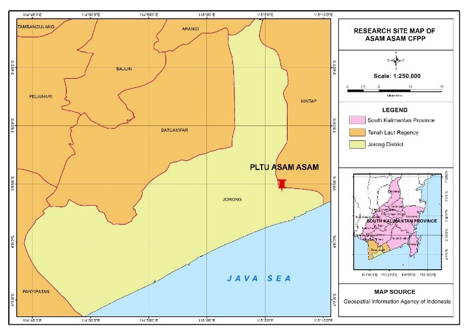The Effect of Coal and Biomass on the Generation of Fly Ash and Bottom Ash at the Coal-Fired Power Plant Asam Asam Unit 1-4, South Kalimantan
Main Article Content
Khoirul Abidin
Mochammad Chaerul
Background: One of the main environmental challenges in Coal-Fired Power Plant (CFPP) operations is the large amount of Fly Ash and Bottom Ash (FABA) produced, which creates significant waste management issues. Reducing FABA production through biomass co-firing has become a potential solution, yet its effectiveness in actual operations remains underexplored. Asam Asam Power Plant Unit 1–4, with a capacity of 4 × 65 MW in South Kalimantan, is one of the power plants that utilize sawdust biomass in its operations.
Aims: This study aims to analyze the effect of coal and biomass consumption on FABA generation during 2022, 2023, and 2024.
Methods: The method employed is multiple linear regression using Minitab version 21.4.1 software, with coal consumption (X1) and biomass consumption (X2) as independent variables and FABA generation (Y) as the dependent variable.
Result: The results show that coal consumption has a positive relationship with FABA generation, while biomass consumption shows a negative relationship. ANOVA test results indicate that only coal consumption significantly affects FABA generation. A notable decrease in FABA production in 2024 signifies an increase in biomass utilization in the fuel mixture, highlighting its potential in reducing solid waste generation from CFPP operations. A simulation involving three biomass-coal blending scenarios demonstrated that incorporating 20% biomass into the fuel mix can reduce FABA generation by up to 27.79%.
Anggara, F., Besari, D. A. A., Timotius, D., Amijaya, D. H., Hasunah, W. A., Andriani, A., Murti Petrus, H. T. B., Putra, R. D. D., & Fahrialam, A. (2024). Understanding FABA composition in coal-fired power plants: Impact of operating conditions and combustion efficiency on ash characteristics – A case study in PT Bukit Asam, South Sumatra, Indonesia. Results in Engineering, 23, 102590. https://doi.org/10.1016/j.rineng.2024.102590
Apriliyanti, I. D., & Nugraha, D. B. (2025). Burning coal in a cleaner way: Institutional fragmentation, power dynamics, and business influence in Indonesia’s biomass co-firing imaginaries. Energy Research & Social Science, 121, 103949. https://doi.org/10.1016/j.erss.2025.103949
Arimie, C. O., Biu, E. O., & Ijomah, M. A. (2020). Outlier detection and effects on modeling. Open Access Library Journal, 7, e6619. https://doi.org/10.4236/oalib.1106619
Arobi, A. I., Setyo Rini, I. D. W., Saputra, A. A. I., Gunawan, A., Yusriyani, F. N. I., Asyhari, M. M., Junio, E., & Pakendek, Y. (2022). Utilization of Fly Ash and Bottom Ash from Coal-Fired Power Plant Teluk Balikpapan as Subgrade. SSRG International Journal of Civil Engineering, 9(4), 1–7. https://doi.org/10.14445/23488352/IJCE-V9I4P101
Bayu, M. R. P., & Afla, R. A. (2023). Utilization of Fly Ash and Bottom Ash Waste: A Study at PLTU Tanjung Jati B, Jepara, Indonesia. Asian Journal of Toxicology Environmental and Occupational Health, 1(1), 9-19. https://journal-iasssf.com/index.php/AJTEOH/article/view/167
Bhoi, P., Sarkar, S., & Klinger, J. (2023). Performance of biomass and waste coal co-fired power generation. In Proceedings of ASME Power Applied R and D 2023, POWER 2023 (v001t05a003). American Society of Mechanical Engineers. https://doi.org/10.1115/POWER2023-108621
Chen, Y., Fan, Y., Huang, Y., Liao, X., Xu, W., & Zhang, T. (2024). A comprehensive review of toxicity of coal fly ash and its leachate in the ecosystem. Ecotoxicology and Environmental Safety, 269, 115905. https://doi.org/10.1016/j.ecoenv.2023.115905
Daoud, J. I. (2017). Multicollinearity and Regression Analysis. Journal of Physics: Conference Series, 949(1), 012009. https://iopscience.iop.org/article/10.1088/1742-6596/949/1/012009
Eom, J. Y., Yang, S. J., Lee, M. J., Yang, Y. R., Wie, Y. M., Lee, K. G., & Lee, K. H. (2024). Recycling Fly Ash into Lightweight Aggregate: Life Cycle Assessment and Economic Evaluation of Waste Disposal. Sustainability, 16, 9271. https://www.mdpi.com/2071-1050/16/21/9271
Iheaka, V. C. (2025). Diagnosing and correcting violations of normality and constant variance assumptions in multiple linear regression analysis. International Journal of Advanced Statistics and Probability, 12(1), 17–27. https://doi.org/10.14419/8bnsc148
Jarantow, S. W., Pisors, E. D., & Chiu, M. L. (2023). Introduction to the use of linear and nonlinear regression analysis in quantitative biological assays. Current Protocols, 3(6), e801. https://doi.org/10.1002/cpz1.801
Kementerian Energi dan Sumber Daya Mineral Republik Indonesia. (2021). Peraturan Menteri ESDM Nomor 11 Tahun 2021 tentang Pelaksanaan Usaha Ketenagalistrikan.
Kim, F., Ahmed, A., Jamil, F., Rafiq, S., Ayub, H. M. U., Ghauri, M., Khurram, M. S., Munir, S., Inayat, A., Abu Bakar, M. S., Moogi, S., Lam, S. S., & Park, Y.-K. (2024). Co combustion of blends of coal and underutilised biomass residues for environmentally friendly electrical energy production. Sustainability, 13(9), 4881. https://doi.org/10.3390/su13094881
Marganingrum, D., Khalifah, M. N., & Nursetyowati, P. (2022). Cost assessment of biomass coal fuel on air pollution and coal consumption reduction. IOP Conference Series: Earth and Environmental Science, 986(1), 012001. https://doi.org/10.1088/1755-1315/986/1/012001
Matson, J. E., & Huguenard, B. R. (2007). Evaluating Aptness of a Regression Model. Journal of Statistics Education, 15(2). https://doi.org/10.1080/10691898.2007.11889469
Mazarei, A., Sousa, R., Mendes-Moreira, J., Molchanov, S., & Ferreira, H. M. (2025). Online boxplot derived outlier detection. International Journal of Data Science and Analytics, 19(1), 83–97. https://doi.org/10.1007/s41060-024-00559-0
Murphy, J. P., Smith, L. E., & Johnson, R. D. (2023). Biomass co-firing in coal power plants: Efficiency and emission impacts. Journal of Cleaner Production. Retrieved from https://researchportal.murdoch.edu.au/esploro/fulltext/journalArticle/Biomass-Co-firing-in-Coal-Power-Plants/991005729880607891
Pambudi, A., Kukmana, I., & Risano, Y. E. (2023). Pengaruh Nilai Spesifik Konsumsi Bahan Bakar (SFC) Terhadap Jumlah Pemakaian Batubara Di PT Bukit Energi Servis Terpadu PLTU Peltar 2x8 MW. Jurnal Profesi Insinyur (JPI), 4(2), 133–136. https://doi.org/10.23960/jpi.v4n2.109
PT PLN Indonesia Power Unit Bisnis Pembangkitan Asam Asam. (2022). Laporan Pengusahaan PLTU Asam Asam Unit 1-4 Tahun 2022. PT PLN Indonesia Power.
PT PLN Indonesia Power Unit Bisnis Pembangkitan Asam Asam. (2023). Laporan Pengusahaan PLTU Asam Asam Unit 1-4 Tahun 2023. PT PLN Indonesia Power.
PT PLN Indonesia Power Unit Bisnis Pembangkitan Asam Asam. (2024). Laporan Pengusahaan PLTU Asam Asam Unit 1-4 Tahun 2024. PT PLN Indonesia Power.
Rahim, N. L., Mohammed, S. A., Amat, R. U. H. M., Ibrahim, N. M., Hamzah, N., Samsudin, S., Salehuddin, S., & Rahim, M. A. (2023). Waste to Concrete Material: Potential Study of Chemical Characterization of Coal Fly Ash and Bottom Ash. IOP Conference Series: Earth and Environmental Science, 1216, 012023. https://iopscience.iop.org/article/10.1088/1755-1315/1216/1/012023
Rehman, M. A., Abd Rahman, N., Ibrahim, A. N. H., Ahmad Kamal, N., & Ahmad, A. (2024). Estimation of soil erodibility in Peninsular Malaysia: A case study using multiple linear regression and artificial neural networks. Heliyon, 10, e28854. https://doi.org/10.1016/j.heliyon.2024.e28854
Schlupp, F., Page, J., Djelal, C., Libessart, L. (2024). Use of Biomass Bottom Ash as an Alternative Solution to Natural Aggregates in Concrete Applications: A Review. Materials, 17(18), 4504. https://doi.org/10.3390/ma17184504
Sundus, K. I., Hammo, B. H., Al-Zoubi, M. B., & Al-Omari, A. (2022). Solving the multicollinearity problem to improve the stability of machine learning algorithms applied to a fully annotated breast cancer dataset. Informatics in Medicine Unlocked, 33, 101088. https://doi.org/10.1016/j.imu.2022.101088
Song, J. (2024). Application of hypothesis testing in estimating regression models. Proceedings of the 2nd International Conference on Mathematical Physics and Computational Simulation. http://dx.doi.org/10.54254/2753-8818/39/20240596
Suripto, S., Saleh, K., & Syukriadinata, A. (2024). Processing Fly Ash and Bottom Ash (FABA) Waste into Briquettes as an Effort to Control Environmental Pollution at the West Sumbawa Steam Power Plant. Jurnal Pengabdian Magister Pendidikan IPA, 7(3), 1004-1011. https://jppipa.unram.ac.id/index.php/jpmpi/article/view/9167
Turner, S., Lin, Y., & Roberts, M. (2023). A comprehensive review of biomass briquette integration for coal co-firing. International Journal of Coal Science & Technology, 13, Article 00779. https://doi.org/10.1007/s40789-025-00779-0
Uyanto, S. S. (2020). Power comparisons of five most commonly used autocorrelation tests. Pakistan Journal of Statistics and Operation Research, 16(1), 119–130. https://doi.org/10.18187/pjsor.v16i1.2691
Wu, M., Wei, K., Jiang, J., Xu, B. B., & Ge, S. (2025). Advancing green sustainability: A comprehensive review of biomass briquette integration for coal based energy frameworks. International Journal of Coal Science & Technology, 12(44). https://doi.org/10.1007/s40789-025-00779-0
Yana, S., Nizar, M., Irhamni, M., & Mulyati, D. (2022). Biomass waste as a renewable energy in developing bio-based economies in Indonesia: A review. Renewable and Sustainable Energy Reviews, 160, 112268. Elsevier Ltd. https://doi.org/10.1016/j.rser.2022.112268
Zhai, M., Tian, X., Liu, Z., Zhao, Y., Deng, Y., & Yang, W. (2025). Advancing just transition: The role of biomass co-firing in emission reductions and employment for coal regions. Sustainable Energy Technologies and Assessments, 75, 104246. https://doi.org/10.1016/j.seta.2025.104246
Zhang, W., Lim, M. K., Yang, M., Li, X., & Ni, D. (2023). Using deep learning to interpolate the missing data in time-series for credit risks along supply chain. Industrial Management & Data Systems, 123(5), 1401–1417. https://doi.org/10.1108/IMDS-08-2022-0468
Khoirul Abidin , PT PLN Indonesia Power, Jakarta, Indonesia
Department of Environmental Engineering, Faculty of Civil and Environmental Engineering, Institut Teknologi Bandung, Indonesia
PT PLN Indonesia Power, Jakarta, Indonesia
Mochammad Chaerul , Institut Teknologi Bandung, Indonesia
Department of Environmental Engineering, Faculty of Civil and Environmental Engineering, Institut Teknologi Bandung, Indonesia








